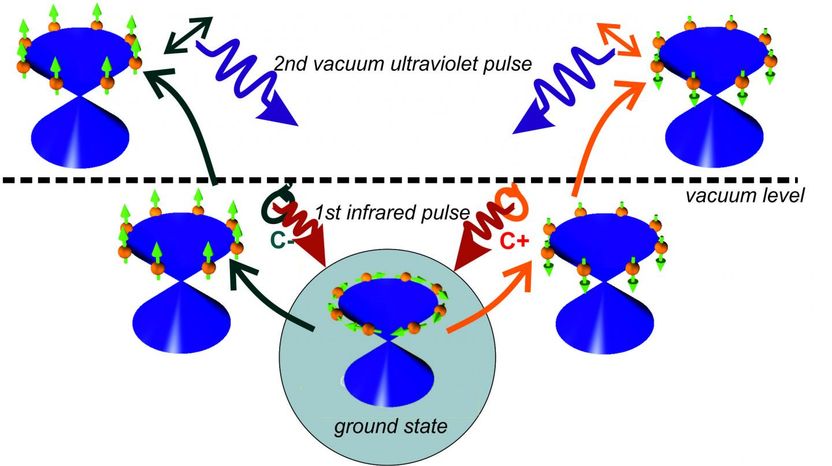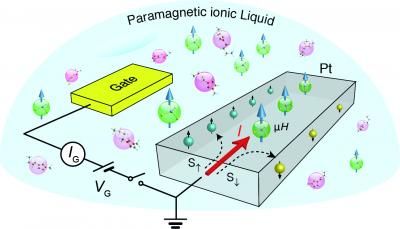Spintronics for future information technologies
Spin currents in topological insulators controlled
Future information technologies should employ considerably less energy for processing data. One exciting class of materials for this comprises topological insulators. Topological insulators are distinguished by their electrons at the surface being extremely mobile, while the bulk material within is an insulator and does not conduct. Since electrons also simultaneously carry a magnetic moment (spin), topological insulators might also make "spintronic" components feasible. Spintronic components would not be based on the movement of charge carriers like electrons (as in semiconductor components), but instead on the transport or manipulation of their spins. This would require considerably less energy.

The illustration depicts the characteristic spin orientation (arrows) of electrons in a topological insulator (below). Using an initial circular polarised laser pulse, the spins are excited and point up or down. This can be proven by a second linearly polarised laser pulse (above).
HZB
An international team headed by HZB physicist Jaime Sánchez-Barriga has now shown how the spins of the electrons in topological insulators can be controlled. The team investigated samples of antimony-telluride, a topological insulator, using circularly polarised laser light. They were able to initiate and direct currents of electrons whose spins were oriented in parallel (i. e., spin-polarised currents) using the "rotational direction" of the laser light. In addition, they were successful in changing the orientation of the spins as well. The team was made up of experimentalists from the Max Born Institute in Berlin and Lomonossow University Moscow, together with theoreticians from Ludwig-Maximilians-Universität München (LMU).
"If you were to utilise magnetically doped topological insulators, you could also probably store this spin information", explains Oliver Rader, who heads the research group for green spintronics at HZB. "To investigate this however, and also be able to explore the dynamic behaviour of the magnetic moments in particular, ultra-short light pulses in the soft X-ray region are needed. These kinds of experiments can become standard with the planned upgrade of the BESSY II synchrotron source to BESSY-VSR", he hopes.
Original publication
Other news from the department science

Get the chemical industry in your inbox
By submitting this form you agree that LUMITOS AG will send you the newsletter(s) selected above by email. Your data will not be passed on to third parties. Your data will be stored and processed in accordance with our data protection regulations. LUMITOS may contact you by email for the purpose of advertising or market and opinion surveys. You can revoke your consent at any time without giving reasons to LUMITOS AG, Ernst-Augustin-Str. 2, 12489 Berlin, Germany or by e-mail at revoke@lumitos.com with effect for the future. In addition, each email contains a link to unsubscribe from the corresponding newsletter.



























































